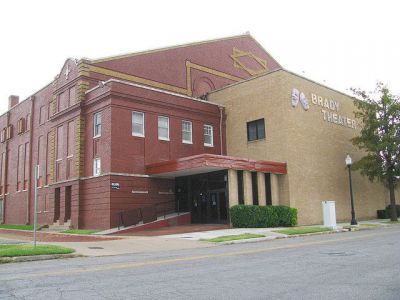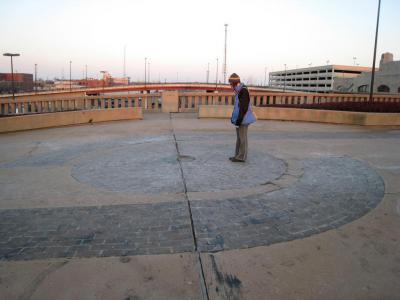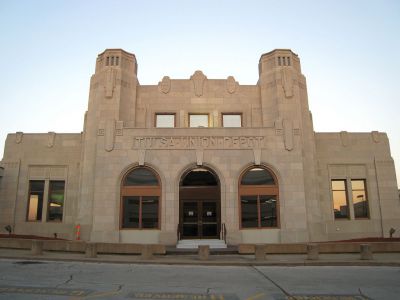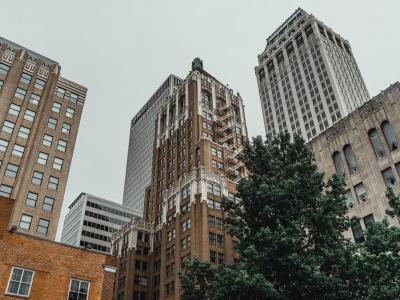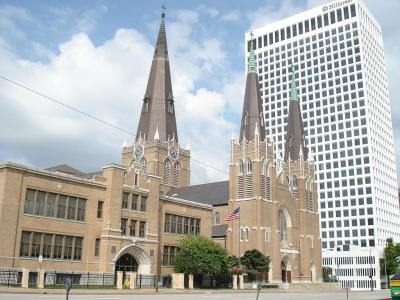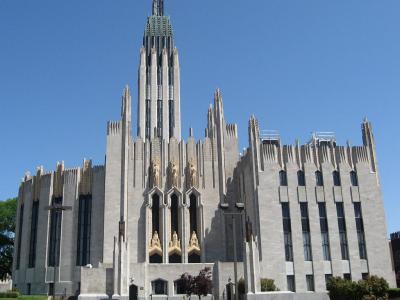Tulsa Introduction Walking Tour (Self Guided), Tulsa
Straddling the Arkansas River in the U.S. state of Oklahoma, the city of Tulsa is deeply rooted in the Native American history and, more recently, in the oil industry too.
The area of modern Tulsa is considered an Indian Territory, and has been formally settled by Native Americans since 1836. The tribesmen named their settlement Tallasi, which means "old town" in the Creek language, which later became "Tulsa".
The city was officially incorporated in 1898, and, following the discovery of the grand Glenn Pool Oil Reserve in 1905, had seen a surge in population prompted by a rush of entrepreneurs. Known as the "Oil Capital of the World" for most of the 20th century, the city's success in the energy industry fueled construction booms in the popular Art Deco style of the time, resulting in a number of eye-catching structures, such as the Boston Avenue Methodist Church, the Philtower, and more.
Profits from the oil industry continued through the Great Depression, helping the city's economy fare better than most in the United States during the 1930s. The completion of U.S. Route 66 around that time, linking Chicago to Los Angeles, was initiated in Tulsa and has subsequently earned it the nickname "the Birthplace of Route 66". The road played an important role in the city's development as a popular rest stop for travelers.
Owing to its master plan envisaging the construction of parks, churches, museums, and improving infrastructure, in the 1950s Time magazine dubbed Tulsa as "America's Most Beautiful City."
Tulsa's large conservative following, with the majority of locals being Christians, is reflected in a high percentage of Catholics, descendants of the settlers arrived during the oil boom. The Roman Catholic Holy Family Cathedral, the mother church of the Diocese of Tulsa, is now one of the city's key local attractions.
On the artistic side, the prominent downtown sub-district Brady Arts is a home to the Brady Theater, a major performing arts venue, currently listed on the National Register of Historic Places. Another key location, the centerpiece of the Tulsa Arts District, is the Woody Guthrie Center, famed among other things for its association with singer-songwriter Bob Dylan, whose archive is showcased here.
For a more detailed acquaintance with Tulsa and to experience the warmth of Midwestern nostalgia, take this self-guided walking tour.
The area of modern Tulsa is considered an Indian Territory, and has been formally settled by Native Americans since 1836. The tribesmen named their settlement Tallasi, which means "old town" in the Creek language, which later became "Tulsa".
The city was officially incorporated in 1898, and, following the discovery of the grand Glenn Pool Oil Reserve in 1905, had seen a surge in population prompted by a rush of entrepreneurs. Known as the "Oil Capital of the World" for most of the 20th century, the city's success in the energy industry fueled construction booms in the popular Art Deco style of the time, resulting in a number of eye-catching structures, such as the Boston Avenue Methodist Church, the Philtower, and more.
Profits from the oil industry continued through the Great Depression, helping the city's economy fare better than most in the United States during the 1930s. The completion of U.S. Route 66 around that time, linking Chicago to Los Angeles, was initiated in Tulsa and has subsequently earned it the nickname "the Birthplace of Route 66". The road played an important role in the city's development as a popular rest stop for travelers.
Owing to its master plan envisaging the construction of parks, churches, museums, and improving infrastructure, in the 1950s Time magazine dubbed Tulsa as "America's Most Beautiful City."
Tulsa's large conservative following, with the majority of locals being Christians, is reflected in a high percentage of Catholics, descendants of the settlers arrived during the oil boom. The Roman Catholic Holy Family Cathedral, the mother church of the Diocese of Tulsa, is now one of the city's key local attractions.
On the artistic side, the prominent downtown sub-district Brady Arts is a home to the Brady Theater, a major performing arts venue, currently listed on the National Register of Historic Places. Another key location, the centerpiece of the Tulsa Arts District, is the Woody Guthrie Center, famed among other things for its association with singer-songwriter Bob Dylan, whose archive is showcased here.
For a more detailed acquaintance with Tulsa and to experience the warmth of Midwestern nostalgia, take this self-guided walking tour.
How it works: Download the app "GPSmyCity: Walks in 1K+ Cities" from Apple App Store or Google Play Store to your mobile phone or tablet. The app turns your mobile device into a personal tour guide and its built-in GPS navigation functions guide you from one tour stop to next. The app works offline, so no data plan is needed when traveling abroad.
Tulsa Introduction Walking Tour Map
Guide Name: Tulsa Introduction Walking Tour
Guide Location: USA » Tulsa (See other walking tours in Tulsa)
Guide Type: Self-guided Walking Tour (Sightseeing)
# of Attractions: 8
Tour Duration: 2 Hour(s)
Travel Distance: 2.9 Km or 1.8 Miles
Author: karenl
Sight(s) Featured in This Guide:
Guide Location: USA » Tulsa (See other walking tours in Tulsa)
Guide Type: Self-guided Walking Tour (Sightseeing)
# of Attractions: 8
Tour Duration: 2 Hour(s)
Travel Distance: 2.9 Km or 1.8 Miles
Author: karenl
Sight(s) Featured in This Guide:
- Brady Theater
- Woody Guthrie Center
- Center of the Universe
- Oklahoma Jazz Hall of Fame
- Tulsa Performing Arts Center
- Philtower Building
- Holy Family Cathedral
- Boston Avenue United Methodist Church
1) Brady Theater
The Tulsa Theater is both a theater and convention hall in Tulsa. The theater was built in 1914 as the Tulsa Convention Hall. At the time, it was known as the largest convention hall between Kansas City and Houston. The building was designed by architects Rose and Peterson.
The theater underwent several renovations over the years. Most notably, in 1930 it was remodeled into an Art Deco style by architect Bruce Goff. Likewise, in 1952, lobbies were added in the Western Classical Revival style.
The building was previous known as Brady Theater. This was due to the fact that the previous name was in honor of known Ku Klux Klan member W. Tate Brady. Locals often refer to the theater as "The Old Lady on Brady" because of its location on what used to be Brady Street. That street was renamed Reconciliation Way in 2019.
The Tulsa Theater is known for lavish productions, but it also holds a dark place in history. It was used as a detention center by the National Guard during the 1921 Race Riot. The theater was added to the National Register of Historic Places in 1979.
The theater underwent several renovations over the years. Most notably, in 1930 it was remodeled into an Art Deco style by architect Bruce Goff. Likewise, in 1952, lobbies were added in the Western Classical Revival style.
The building was previous known as Brady Theater. This was due to the fact that the previous name was in honor of known Ku Klux Klan member W. Tate Brady. Locals often refer to the theater as "The Old Lady on Brady" because of its location on what used to be Brady Street. That street was renamed Reconciliation Way in 2019.
The Tulsa Theater is known for lavish productions, but it also holds a dark place in history. It was used as a detention center by the National Guard during the 1921 Race Riot. The theater was added to the National Register of Historic Places in 1979.
2) Woody Guthrie Center (must see)
The Woody Guthrie Center, located in Tulsa’s vibrant Arts District, is a museum and archive dedicated to the life, work, and enduring legacy of American folk legend Woody Guthrie. More than a traditional museum, the Center serves as a creative hub and educational resource, highlighting Guthrie’s impact as a musician, artist, and advocate for social justice.
Opened in 2013 through the efforts of the George Kaiser Family Foundation, the Center houses the world’s largest collection of Guthrie-related material-including manuscripts, lyrics, drawings, photographs, and personal belongings. Visitors can explore an interactive museum with handwritten lyrics, original instruments, rare artwork, and immersive displays that trace Guthrie’s journey through music and activism. A short biographical film, listening stations, and exhibits on artists influenced by Guthrie add further depth to the experience.
The Center also preserves the archives of fellow protest singer and activist Phil Ochs, donated by his daughter Meegan Lee Ochs in 2014. This marked the first major collection from another artist housed alongside Guthrie’s, reflecting the Center’s broader commitment to the folk tradition and its role in American cultural history.
Researchers can access the extensive Guthrie archives by appointment, housed in a climate-controlled facility partially visible from the public gallery. Educational programs support students, teachers, and scholars in exploring themes of creativity, equity, and expression.
A standout feature is the Dust Bowl virtual reality experience, which lets visitors relive the harsh conditions that shaped Guthrie’s worldview and music. Seated on a recreated front porch with a VR headset, guests are immersed in the storms that uprooted lives and inspired some of Guthrie’s most poignant songs.
As a companion institution to the nearby Bob Dylan Center, the Woody Guthrie Center is a vital space for remembering the past, understanding its messages, and igniting future voices.
Opened in 2013 through the efforts of the George Kaiser Family Foundation, the Center houses the world’s largest collection of Guthrie-related material-including manuscripts, lyrics, drawings, photographs, and personal belongings. Visitors can explore an interactive museum with handwritten lyrics, original instruments, rare artwork, and immersive displays that trace Guthrie’s journey through music and activism. A short biographical film, listening stations, and exhibits on artists influenced by Guthrie add further depth to the experience.
The Center also preserves the archives of fellow protest singer and activist Phil Ochs, donated by his daughter Meegan Lee Ochs in 2014. This marked the first major collection from another artist housed alongside Guthrie’s, reflecting the Center’s broader commitment to the folk tradition and its role in American cultural history.
Researchers can access the extensive Guthrie archives by appointment, housed in a climate-controlled facility partially visible from the public gallery. Educational programs support students, teachers, and scholars in exploring themes of creativity, equity, and expression.
A standout feature is the Dust Bowl virtual reality experience, which lets visitors relive the harsh conditions that shaped Guthrie’s worldview and music. Seated on a recreated front porch with a VR headset, guests are immersed in the storms that uprooted lives and inspired some of Guthrie’s most poignant songs.
As a companion institution to the nearby Bob Dylan Center, the Woody Guthrie Center is a vital space for remembering the past, understanding its messages, and igniting future voices.
3) Center of the Universe (must see)
The Center of the Universe is a small, concrete circle surrounded by bricks. It is between Archer Street and MLK Jr. Boulevard. It is known as an acoustic phenomenon due to the fact that standing on the circle allows one's voice to be echoed and distorted at an amplified volume.
Those near the Center of the Universe can take advantage of the brick pavers placed nearby. These signify spots where passersby can hear the strange sound effect from those who are inside the circle.
The project was designed by architect John Laur of JKL Architecture. The purpose was not to create an auditory anomaly but to serve as a decorative outdoor walking path. It is thought that the low planter walls nearby reflect the sounds, which causes the delayed echo.
The Center of the Universe can be reached at any time of the day or night. There is no admission, but visitors might have to wait for others to take their time enjoying the mystery spot.
Those near the Center of the Universe can take advantage of the brick pavers placed nearby. These signify spots where passersby can hear the strange sound effect from those who are inside the circle.
The project was designed by architect John Laur of JKL Architecture. The purpose was not to create an auditory anomaly but to serve as a decorative outdoor walking path. It is thought that the low planter walls nearby reflect the sounds, which causes the delayed echo.
The Center of the Universe can be reached at any time of the day or night. There is no admission, but visitors might have to wait for others to take their time enjoying the mystery spot.
4) Oklahoma Jazz Hall of Fame
The Oklahoma Jazz Hall of Fame, located in the beautifully restored Tulsa Union Depot, is both a living museum and a vibrant performance venue that celebrates Oklahoma’s deep-rooted legacy in jazz, blues, and gospel music. This iconic downtown Tulsa landmark blends historic Art Deco charm with modern versatility, offering high ceilings, elegant architecture, and flexible event spaces such as the Great Performance Hall, museum galleries, music resource library, and even a VIP Suite. With its built-in stage and capacity to host over 500 guests, it’s a sought-after venue for weddings, concerts, and cultural events.
As a non-profit organization, the Hall of Fame honors legendary Oklahoma musicians, including Chet Baker, Charlie Christian, Don Cherry, Barney Kessel, and Jimmy Rushing, through permanent exhibits and regular live performances. Visitors can explore memorabilia, biographical displays, and archival materials that spotlight the state’s musical giants.
Since its founding, the Oklahoma Jazz Hall of Fame has inducted over 100 artists and groups. Its annual induction ceremony, now held each November, began in 1988 with educator Zelia N. Breaux as its first honoree. The institution also presents the Jay McShann Lifetime Achievement Award, established in 1999, to recognize artists like Dave Brubeck, Ramsey Lewis, Bob Wills, and Nat King Cole for their enduring influence.
Notably, jazz guitarist Barney Kessel delivered his final public speech at the Hall in 1991, and vocalist Joe Lee Wilson gave his last performance during his 2010 induction-moments that further rooted the Jazz Depot in the living history of American music.
Located on East First Street, the Oklahoma Jazz Hall of Fame remains a dynamic hub for music education, celebration, and performance in Tulsa.
As a non-profit organization, the Hall of Fame honors legendary Oklahoma musicians, including Chet Baker, Charlie Christian, Don Cherry, Barney Kessel, and Jimmy Rushing, through permanent exhibits and regular live performances. Visitors can explore memorabilia, biographical displays, and archival materials that spotlight the state’s musical giants.
Since its founding, the Oklahoma Jazz Hall of Fame has inducted over 100 artists and groups. Its annual induction ceremony, now held each November, began in 1988 with educator Zelia N. Breaux as its first honoree. The institution also presents the Jay McShann Lifetime Achievement Award, established in 1999, to recognize artists like Dave Brubeck, Ramsey Lewis, Bob Wills, and Nat King Cole for their enduring influence.
Notably, jazz guitarist Barney Kessel delivered his final public speech at the Hall in 1991, and vocalist Joe Lee Wilson gave his last performance during his 2010 induction-moments that further rooted the Jazz Depot in the living history of American music.
Located on East First Street, the Oklahoma Jazz Hall of Fame remains a dynamic hub for music education, celebration, and performance in Tulsa.
5) Tulsa Performing Arts Center
The Tulsa Performing Arts Center (Tulsa PAC) is a cultural cornerstone of Tulsa, known for its architectural pedigree, world-class acoustics, and vibrant programming. Opened on March 19, 1977, the PAC is home to four main theaters, including the 2,365-seat Chapman Music Hall, as well as studio spaces, an art gallery, and a spacious reception hall.
The PAC is a hub for both local and touring performances. It regularly hosts events from 14 Tulsa-based performance groups, including the Tulsa Opera, Tulsa Ballet, Tulsa Symphony, and Celebrity Attractions' Broadway series. Other local companies such as Theatre Tulsa, American Theatre Company, and Chamber Music Tulsa also keep the venue’s calendar full. Over the years, the stage has welcomed major stars like Michael Bublé, Kelly Clarkson, Steve Martin, and Anthony Bourdain.
The venue was designed by Minoru Yamasaki, architect of the original World Trade Center towers, and built with a mix of public and private funding. Its creation was sparked in the 1970s when the outdated Tulsa Municipal Theatre prompted the formation of a Theatre Advisory Committee. A major turning point came in 1973 when John H. Williams and Leta Chapman pledged to match public funds, helping pass a bond election under the slogan “Everyone’s Place.”
One percent of the construction cost was set aside for public art, by a 1969 ordinance. As a result, the PAC boasts a permanent collection of 76 works of art, featuring pieces by Louise Nevelson, Barbara Hepworth, Woody Crumbo, and other notable artists, including many from Native American traditions.
The PAC has seen continual upgrades: a major accessibility retrofit in the 1990s and an expansion in 2000 that added another studio theater, an expansive reception area, and additional amenities. Today, the Tulsa PAC remains a beacon for the performing arts in the region and a vital part of the city's cultural identity.
The PAC is a hub for both local and touring performances. It regularly hosts events from 14 Tulsa-based performance groups, including the Tulsa Opera, Tulsa Ballet, Tulsa Symphony, and Celebrity Attractions' Broadway series. Other local companies such as Theatre Tulsa, American Theatre Company, and Chamber Music Tulsa also keep the venue’s calendar full. Over the years, the stage has welcomed major stars like Michael Bublé, Kelly Clarkson, Steve Martin, and Anthony Bourdain.
The venue was designed by Minoru Yamasaki, architect of the original World Trade Center towers, and built with a mix of public and private funding. Its creation was sparked in the 1970s when the outdated Tulsa Municipal Theatre prompted the formation of a Theatre Advisory Committee. A major turning point came in 1973 when John H. Williams and Leta Chapman pledged to match public funds, helping pass a bond election under the slogan “Everyone’s Place.”
One percent of the construction cost was set aside for public art, by a 1969 ordinance. As a result, the PAC boasts a permanent collection of 76 works of art, featuring pieces by Louise Nevelson, Barbara Hepworth, Woody Crumbo, and other notable artists, including many from Native American traditions.
The PAC has seen continual upgrades: a major accessibility retrofit in the 1990s and an expansion in 2000 that added another studio theater, an expansive reception area, and additional amenities. Today, the Tulsa PAC remains a beacon for the performing arts in the region and a vital part of the city's cultural identity.
6) Philtower Building
The Philtower Building is a striking architectural landmark located on South Boston Avenue in downtown Tulsa. Completed in 1928, it was commissioned by oil magnate and philanthropist Waite Phillips, who also financed the project. Designed by architect Edward Buehler Delk with construction supervision by Keene & Simpson, the building is an elegant blend of Neo-Gothic and Art Deco styles-features that define much of Tulsa's historic skyline.
One of its most recognizable elements is the illuminated, steeply tiled roof, which makes the Philtower instantly identifiable against the city’s evening backdrop. Inside, the building boasts a vaulted lobby ceiling adorned with large stone rosettes carved in Italy and installed by the original artisans, adding to its grandeur.
Waite Phillips maintained an office on the 21st floor, which has been preserved as a historic space. In 1941, he gifted the Philtower to the Boy Scouts of America, along with his Philmont Ranch and Villa Philmonte, using the building’s income to support scouting programs. The BSA retained ownership until 1977 when it was sold to a group of local investors-The Philtower LLC-who continue to own it today.
Standing 323 feet tall with 24 floors, the Philtower was originally an office tower but became Tulsa’s first mixed-use high-rise when its 12th through 20th floors were converted into loft apartments in 2004. It was added to the National Register of Historic Places in 1979 and became part of the Oil Capital Historic District in 2010, cementing its status as a symbol of Tulsa’s oil-era legacy and architectural heritage.
One of its most recognizable elements is the illuminated, steeply tiled roof, which makes the Philtower instantly identifiable against the city’s evening backdrop. Inside, the building boasts a vaulted lobby ceiling adorned with large stone rosettes carved in Italy and installed by the original artisans, adding to its grandeur.
Waite Phillips maintained an office on the 21st floor, which has been preserved as a historic space. In 1941, he gifted the Philtower to the Boy Scouts of America, along with his Philmont Ranch and Villa Philmonte, using the building’s income to support scouting programs. The BSA retained ownership until 1977 when it was sold to a group of local investors-The Philtower LLC-who continue to own it today.
Standing 323 feet tall with 24 floors, the Philtower was originally an office tower but became Tulsa’s first mixed-use high-rise when its 12th through 20th floors were converted into loft apartments in 2004. It was added to the National Register of Historic Places in 1979 and became part of the Oil Capital Historic District in 2010, cementing its status as a symbol of Tulsa’s oil-era legacy and architectural heritage.
7) Holy Family Cathedral
Holy Family Cathedral is a Roman Catholic cathedral and the mother church of the Diocese of Tulsa. Construction of the church began in 1912. It was dedicated only two years later though the church wasn't finished until 1927. It was designed in the Gothic Revival and Classic Revival architectural styles by J.P. Curtin of Curtin, Winkler and Macdonald.
Holy Family Cathedral was the tallest building in Tulsa until 1923 when it was overshadowed by the Mayo Hotel. Its height came from the single spire, which is somewhat unique in Gothic architecture. The cathedral and its buildings were placed on the National Register of Historic Places in 1982.
The stained glass windows may be viewed from both inside and outside of the cathedral. These windows were replicated from stained glass created by the Royal Bavarian Art Institute in Munich. The windows are original to the building.
Those who wish to admire the interior architecture and stained glass may do so via a guided tour. These tours are available from Tuesday through Friday from 9 AM to 4 PM.
Holy Family Cathedral was the tallest building in Tulsa until 1923 when it was overshadowed by the Mayo Hotel. Its height came from the single spire, which is somewhat unique in Gothic architecture. The cathedral and its buildings were placed on the National Register of Historic Places in 1982.
The stained glass windows may be viewed from both inside and outside of the cathedral. These windows were replicated from stained glass created by the Royal Bavarian Art Institute in Munich. The windows are original to the building.
Those who wish to admire the interior architecture and stained glass may do so via a guided tour. These tours are available from Tuesday through Friday from 9 AM to 4 PM.
8) Boston Avenue United Methodist Church (must see)
The Boston Avenue United Methodist Church in downtown Tulsa stands as a towering icon of American Art Deco ecclesiastical architecture. Completed in 1929 and reaching 15 floors high, it is considered one of the finest religious examples of the style in the U.S. Recognized for its significance, the building was placed on the National Register of Historic Places in 1978 and designated a National Historic Landmark in 1999.
The church’s design is attributed to a unique collaboration-Adah Robinson, a Tulsa art teacher, and Bruce Goff, her former student and rising architect. While Robinson sketched the original ideas and is officially credited by the church, Goff, who was with the firm Rush, Endacott, and Rush, developed the architectural plans. The debate over authorship remains unresolved, but the result is universally admired.
The structure features a 225-foot tower, a semi-circular auditorium, and an educational wing. Embracing verticality in the spirit of both Gothic cathedrals and Art Deco’s upward thrust, the church is adorned with stylized praying hands, a motif rooted in Robinson’s original sketches. Materials like limestone, granite, terra cotta, glass, and metal are masterfully integrated, while sculptor Robert Garrison-also a former student of Robinson-contributed detailed terra cotta figures that depict religious scenes and Oklahoma flora.
Above the south entrance, equestrian sculptures honor the early Methodist Circuit Riders, including Bishops Francis Asbury and William McKendree. The north entrance features idealized statues of John, Charles, and Susanna Wesley, anchoring the church’s Methodist identity.
Inside, the building features a Möller pipe organ with 105 ranks, expanded multiple times since its original 1962 installation. A columbarium, completed in 2000 and featuring a stained-glass window by Richard Bohm, now offers interment for church members and their families. In 1993, murals by Angelo Gherardi were added for the congregation’s centennial, continuing the Art Deco aesthetic.
Even beyond Tulsa, the church has left its mark-literally. A stone from its structure is embedded in the Chicago Tribune Tower, joining stones from iconic buildings worldwide.
The church’s design is attributed to a unique collaboration-Adah Robinson, a Tulsa art teacher, and Bruce Goff, her former student and rising architect. While Robinson sketched the original ideas and is officially credited by the church, Goff, who was with the firm Rush, Endacott, and Rush, developed the architectural plans. The debate over authorship remains unresolved, but the result is universally admired.
The structure features a 225-foot tower, a semi-circular auditorium, and an educational wing. Embracing verticality in the spirit of both Gothic cathedrals and Art Deco’s upward thrust, the church is adorned with stylized praying hands, a motif rooted in Robinson’s original sketches. Materials like limestone, granite, terra cotta, glass, and metal are masterfully integrated, while sculptor Robert Garrison-also a former student of Robinson-contributed detailed terra cotta figures that depict religious scenes and Oklahoma flora.
Above the south entrance, equestrian sculptures honor the early Methodist Circuit Riders, including Bishops Francis Asbury and William McKendree. The north entrance features idealized statues of John, Charles, and Susanna Wesley, anchoring the church’s Methodist identity.
Inside, the building features a Möller pipe organ with 105 ranks, expanded multiple times since its original 1962 installation. A columbarium, completed in 2000 and featuring a stained-glass window by Richard Bohm, now offers interment for church members and their families. In 1993, murals by Angelo Gherardi were added for the congregation’s centennial, continuing the Art Deco aesthetic.
Even beyond Tulsa, the church has left its mark-literally. A stone from its structure is embedded in the Chicago Tribune Tower, joining stones from iconic buildings worldwide.
Walking Tours in Tulsa, Oklahoma
Create Your Own Walk in Tulsa
Creating your own self-guided walk in Tulsa is easy and fun. Choose the city attractions that you want to see and a walk route map will be created just for you. You can even set your hotel as the start point of the walk.
Tulsa's Historical Churches
Tulsa, Oklahoma is home to an array of remarkable churches, cathedrals, chapels, and other religious sites collectively reflecting the city's diverse religious heritage. A good number of these sanctuaries are located downtown. By far more than just places of worship, they are also architectural marvels and cultural landmarks.
Boston Avenue United Methodist Church, with its striking Art... view more
Tour Duration: 1 Hour(s)
Travel Distance: 1.6 Km or 1 Miles
Boston Avenue United Methodist Church, with its striking Art... view more
Tour Duration: 1 Hour(s)
Travel Distance: 1.6 Km or 1 Miles
University of Tulsa Walking Tour
Located on the historic U.S. Route 66, America's "Mother Road", the University of Tulsa campus centers on a wide, grassy, quad-like space, known as Dietler Commons. Formerly called "The U", it is found not far from the downtown area and is dominated by English Gothic architecture.
At the top of Deitler Commons sits one of the campus' most notable landmarks, the... view more
Tour Duration: 1 Hour(s)
Travel Distance: 1.3 Km or 0.8 Miles
At the top of Deitler Commons sits one of the campus' most notable landmarks, the... view more
Tour Duration: 1 Hour(s)
Travel Distance: 1.3 Km or 0.8 Miles
The Most Popular Cities
/ view all



